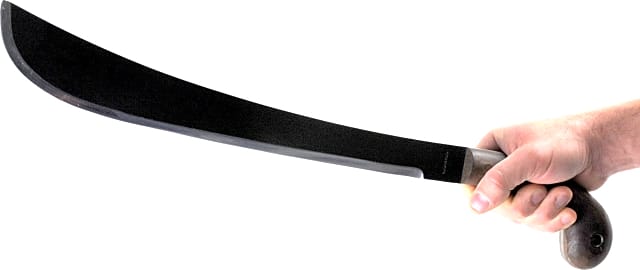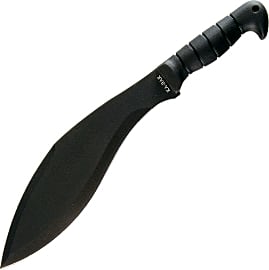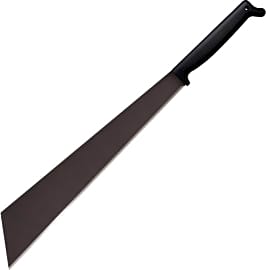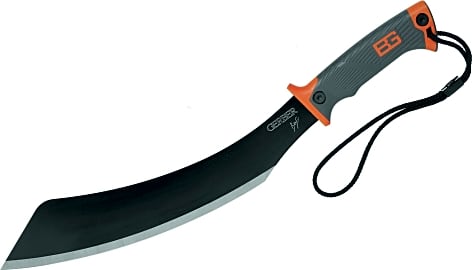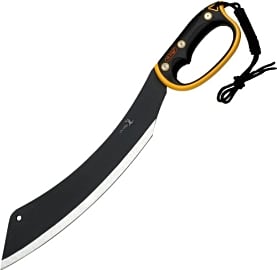The 10 Best Machetes

This wiki has been updated 45 times since it was first published in September of 2015. Hacking your way through virgin trails while hiking or hunting requires a powerful tool. These machetes are built for a wide range of tasks that you might perform when venturing off the beaten path. Our selection includes options for everyone, from brush-clearing property owners to casual outdoorspersons to serious survivalists, ranked by their cutting power, handling comfort, and durability. When users buy our independently chosen editorial choices, we may earn commissions to help fund the Wiki.
Editor's Notes
August 13, 2020:
Removed the My Parang Duku Chandong in favor of the Tops MAC230.
Considering the tasks we ask machetes to perform, it seems to me that a full-tang is extremely important. Machetes like the Tops MAC230 and the Condor Golok are designed with full tangs precisely because they raise the upper limit of the amount of force you can leverage with the blade. Partial tang machetes like the Cold Steel All Terrain Chopper and the Gerber Bear Grylls Parang do have to be used with a bit more restraint given that there isn't as much stock in the handle to absorb impacts. This undoubtedly creates a weak point where the stock tapers off. This doesn't mean that they are bad machetes, of course - they are simply providing more affordable options.
The Tops MAC230 also manages to strike a good balance between weight and durability. Often thick blades are used to help mask poor quality steels. I think that this ends up compounding the issues. You get a very heavy tool whose edge rolls over anyway. The Tops on the other hand, uses a modest 1/8th-inch blade but it is made out of 1095 steel and also has a profile where the entire length of the blade is well-supported. Since 1095 has a high carbon content, it is tough and holds a good edge, but is also more prone to rust. To mitigate this, the blade has been coated with rust-proofing.
May 09, 2019:
Mostly some minor reodering throughout this ranking based on subtle differences and quirks of usage that allowed one model to rise above another. The long blade and comfortable curved handle of the Condor at number one on last year's list were more than enough to keep it relevant at the top spot. The one item that left the list entirely was the Whetstone Cutlery Full Tang, which ran into some manufacturing issues that cause a high percentage of their blades to snap under enough tension. This not only posed a safety hazard for casual users, but could prove to be the difference between life and death in a survival situation. In its place is a much more capable item by Fiskars, which features a large, weighted end that acts almost like an ax for handling small bits of wood.
How To Choose The Right Machete
Choosing the right machete for your needs means considering the kind of material through which you must hack, be it bamboo, underbrush, or the limbs of a sapling.
There is an elegant simplicity to the machete that helps to explain this tool's worldwide popularity. At the most basic assessment, all cutting implements — be they knives, daggers, or broadswords — are nothing more than a blade attached to a handle. But the machete represents a pinnacle of design in the cutting category.
By affixing a large but lightweight blade to a single-handed grip, a machete allows for maximum chopping force with minimal effort. There is nothing ornamental or ostentatious about a good machete. There is merely efficiency and functionality. Choosing the right machete for your needs means considering the kind of material through which you must hack, be it bamboo, underbrush, or the limbs of a sapling.
A basic machete has a single-sided blade that has a long, sharp edge without serrations or any specialized cutting surfaces. It will taper to a wider point just short of its tip, and it is here, along the last few inches of the blade, that maximum cutting force is concentrated. If you need a tool to help you blaze trails through green underbrush, such as thorns, weeds, slender vines, and flowering plants, the most basic machete is a fine choice trusted by generations of bushwhackers.
They are also great for gardeners or homeowners who just need to clear a few low hanging limbs — a machete costs much less than many pruning tools, so if you don't need to do a lot of yard work, consider the basic machete. Plan for your tool to perform well, but to likely lose its edge quickly with regular use. Fortunately, a machete offers plenty of blade surface for countless resharpening sessions.
Many specialized machetes feature varied cutting surfaces. If you need to do serious clearing of trails or underbrush beyond cutting a one time path, consider a machete with a large serrated surface. This will allow you to saw through limbs or branches hanging in the way of your path (or overhanging your property) and to remove deadfalls from the ground. While a machete with serrations can't hope to match the efficacy of an actual saw, the versatility afforded by the chopping and sawing it allows is helpful when you are traveling into the field and want to minimize the weight carried. Therefore, a machete with a saw surface and a large chopping blade is a great choice for the hunter who needs to make space for a hunting blind or for the camper who needs to clear an area to pitch his or her tent.
How To Sharpen Your Machete
Keeping a standard machete sharp is easy and, with some practice, won't take more than five minutes of your time. You can always use a store-bought blade sharpener to get the edge back on your machete, but with a few simple tools (which you may already own) you can handle the process yourself.
If you use your machete to cut through green plants only, such as weeds, grasses, and flowering plants, then you want the finest, sharpest edge.
Before you sharpen your machete, you have to decide what edge angle best suits your needs. If you use your machete to cut through green plants only, such as weeds, grasses, and flowering plants, then you want the finest, sharpest edge. Plan to grind the blade at a 20-degree angle for such purposes. If you will be chopping away at branches, vines, or other thicker, woody growth, then sharpen at an angle closer to 30 degrees. Too fine an edge will be quickly lost when chopping thicker plants such as these; the thicker edge may not be as razor sharp, but it will stand up under the chopping you will be doing.
To sharpen the blade, simply immobilize the machete — using a vice grip if possible or the flat of your hand and a stable surface such as a table or wall — and draw a thick, heavy file across the blade at the appropriate angle, completing several passes on each side of the machete until the proper edge has been achieved. Then, remove the burr, which is the slender layer of metal clinging to the edge and often bent over to one side, using a fine file or a steel honing rod.
If you own a belt sander, these powerful tools can also be used to sharpen a machete. Hold the blade at the same angle as specified above with the sander moving past the blade (not against it) and keep the machete constantly moving up and down the surface of the sanding belt. Repeat the process on each side of the blade until it is sharp, and then use a hand tool to remove the burr and hone the edge you have created.
The Machete's Place Around The World
The machete is often unfairly maligned as a weapon used only for violence, when in fact it is first and foremost a versatile tool. The simplicity of design and construction of the machete has made it an affordable and accessible tool useful to people all over the world no matter their economic or geographic situation.
In much of the Caribbean, the machete is still referred to by the largely antiquated term cutlass.
Machetes can be seen harvesting sugar cane in the Americas and clearing old rice fields in Asia. They help clear paths through jungles ranging from the Congo to the Indian subcontinent and help farmers, hunters, and adventurers alike.
What one person calls a machete, however, another might call by another name. If we accept the basic specifications of a machete as being a large, single-sided cutting tool designed for single-handed use and with a blade usually measuring between 12 and 20 inches, then we will see the true universality of this implement.
In much of the Caribbean, the machete is still referred to by the largely antiquated term cutlass. In Africa, a cutting tool known as the panga looks and functions for all intents and purposes like the machete known elsewhere. Many South Asians know the machete as the parang, a large bladed tool often with a distinct sweep to the blade that handles just like a machete and indeed is designed for hacking at think jungle vegetation.
While the machete's ease of production and affordability has seen it used as weapon of offense far too many times, this tool is more often used to help with agriculture, cooking, or the clearing of land for enhanced human use.


